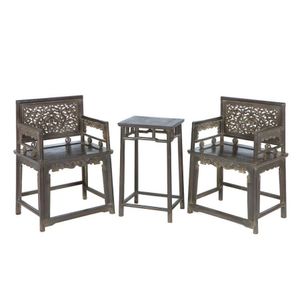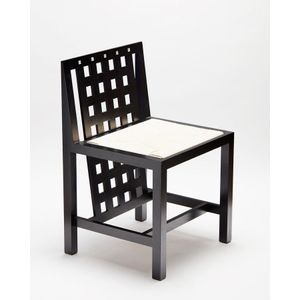Mackintosh Chair with Mother of Pearl Insets
You must be a subscriber, and be logged in to view price and dealer details.
Subscribe Now to view actual auction price for this item
When you subscribe, you have the option of setting the currency in which to display prices to $Au, $US, $NZ or Stg.
- Signed or Stamped - A signed piece of furniture may mean that the maker has signed (and hopefully dated) the piece in the same way that we sign a cheque, but more likely, that it bears evidence of the name of the maker, wholesaler or retailer as a paper label, metal plaque, impressed into the timber or in later pieces after about 1880, stamped onto the timber with an ink stamp.
The 'signature' or stamp will always be in an unobtrusive position: under the top of a table, on the underside of the rails of a chair, inside a drawer or on the back.
The fact that a piece is 'signed' considerably enhances its value. Signed Australian furniture is extremely rare, and for imported furniture, it is a mark of quality of the item, as only the items by the top makers or retailers were 'signed' - Mackintosh, Charles Rennie - Charles Rennie Mackintosh (1868 - 1928) was an important Scottish architect, water colourist and designer duing the Arts & Crafts period.
Born in Glasgow, and at age 15 he began evening classes at the Glasgow School of Art. It was here he met his future wife Margaret Macdonald, who he married in 1900. Together with his wife, his wife's sister and her husband, they exhibited furniture and posters and became known as the 'Glasgow Four".
Mackintosh originally produced graphic work and repousse metalwork in conventional Art Nouveau style, but from the 1890s developed a distinctive simplified style highly influential on Viennese furniture and architecture. - Mother-Of-Pearl - Mother-of-pearl, technical name "nacre", is the inner layer of a sea shell. The iridescent colours and strength of this material were widely used in the nineteenth century as an inlay in jewellery, furniture, (especially papier mache furniture) and musical instruments.
In the early 1900s it was used to make pearl buttons. Mother-of-pearl is a soft material that is easily cut or engraved.
Nowadays it is a by-product of the oyster, freshwater pearl mussel and abalone industries. - Provenance - A term used to describe the provable history of an antique or work of art, and thus an additional aid to verifying its authenticity. Provenance can have an inflating effect on the price of an item, particularly if the provenance relates to the early settlement of Australia, a famous person, or royalty. Less significant are previous sales of the item through an auction house or dealer.
This item has been included into following indexes:
Visually similar items

A pair of low-back armchairs Meiguiyi and a matching side table, 19th/20th century the heavy blackwood resembling zitan, each chair with a straight crestrail continuing through rounded corners to the back posts, enclosing a rectangular openwork panel carve

A pair of William IV mahogany dining chairs

Set of Eight Scandinavian Dining Chairs, c. 1960, each with rosewood frame, pink fabric upholstery (8), height 85 cm width 46 cm depth 42 cm

A set of twelve Biedermeier style gilded leather upholstered elbow chairs, 20th century
